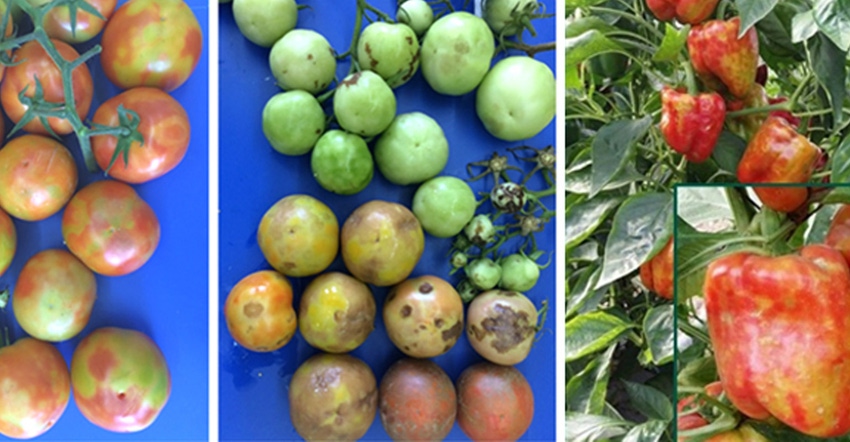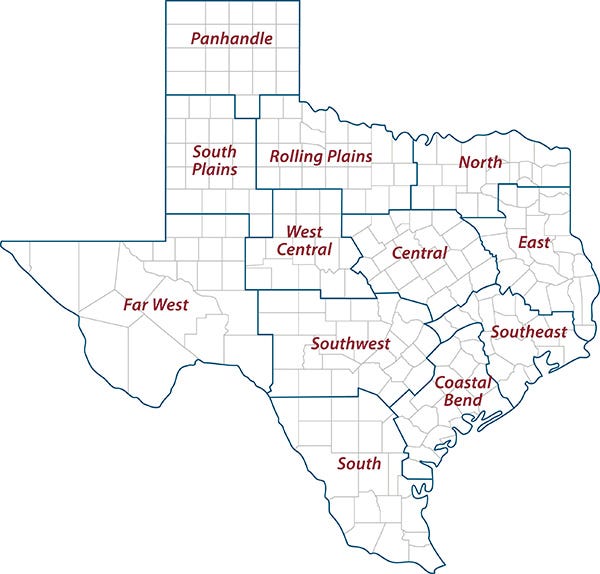
Tomato prices could rise on the heels of an import restriction to scrutinize produce for a disease that could pose a threat to Texas crops, according to Texas A&M AgriLife Extension Service experts.
All tomato imports from Mexico, Israel, the Netherlands and Canada will be inspected for signs of tomato brown rugose fruit virus, according to a U.S. Department of Agriculture order.
The USDA ordered import restrictions on tomato and pepper hosts of the disease to prevent its introduction into the U.S., effective Nov. 22. Inspections and restrictions will be enforced by USDA’s Animal and Plant Health Inspection Service, or APHIS.
The disease has been reported in China, Mexico, Italy, Jordan, Turkey, Greece, the United Kingdom and the Netherlands. It was also reported in Germany, where it was then eradicated.
Luis Ribera, AgriLife Extension economist, College Station, said he and Kevin Ong, AgriLife Extension plant pathologist and director of the Texas Plant Disease Diagnostic Laboratory in College Station, are working with APHIS and other agencies to determine the economic impact of the import restrictions, especially along the Texas-Mexico border.
U.S. ports receive 74,000 truckloads of tomatoes or 2.96 billion pounds from Mexico annually, Ribera said. Around 52.3% of those tomatoes enter through Texas before they hit cold storage and eventually are shipped around the state and country.
Ribera said restrictions placed on tomatoes are causing delays for all produce entering through Mexico. Around 41% of those tomatoes enter through the port of entry in Pharr, while another 11 percent enter through Laredo. Pharr receives 30% of all Mexican agriculture imports into Texas.
“For some perspective, Pharr receives 12,500 trucks of produce per month,” he said. “That’s avocados and onions, leafy greens, peppers, tomatoes and others. The large majority is tomatoes, so we have trucks that are under higher scrutiny as APHIS inspects for disease, which delays the flow of trucks.”
Time literally equals money when it comes to fresh produce, Ribera said.
“Every day produce is delayed the value goes down by 10%,” he said. “So, you want those trucks through as quickly as possible.”
Ribera said the delays could be a big problem but doesn’t expect tomato shortages. Texas would pay a much heavier price if the disease were to become a problem for domestic producers.
“We are used to having good, quality tomatoes in season year-round and at good prices,” he said. “The lion’s share of imported tomatoes in the U.S. originate in Mexico. These delays could mean higher prices but also volatile prices that could fluctuate.”
AgriLife Extension district reporters compiled the following summaries:

CENTRAL: Wheat planting progressed and was nearing completion with favorable conditions. Winter crops got off to a good start with rain. Pasture conditions declined as warm-season perennial grasses went dormant. Stock tanks were showing signs of stress due to limited runoff rainfall, but cattle were in good condition. Winter forage was all planted with some cool-season grasses emerging and growing. Cattle were receiving hay and supplemental feed. Grass fires were reported. Nearly all counties reported short soil moisture conditions.
ROLLING PLAINS: Rain showers helped topsoil moisture. Warmer-than-normal temperatures encouraged emergence of planted wheat. Stocker cattle were slowly being turned out on wheat, but most remained in small pastures and being supplemented with protein and hay. Cotton harvest continued but was slowed by wet conditions.
COASTAL BEND: Wet conditions minimized fieldwork, but growers were gearing up for fertilizer applications to fields and preparations for spring planting. Cotton harvest ended. Some ginning continued. Ratoon rice harvest was almost complete. Forage growth was limited by cool temperatures despite recent rainfall. Supplemental feeding continued for beef cattle herds. Cattle were in fair condition amid milder weather. Livestock markets were still having big runs of weaned calves and cull cows. Pecan harvest continued with yields being fair at best, but the quality was very good.
EAST: Warmer weather and scattered showers were reported. Subsoil and topsoil moisture levels were adequate. Smith County reported it needed more rain. Winter pastures looked good. Most producers began supplementing feed with hay. Pasture and rangeland conditions were fair. Livestock were in fair to good condition. Cattle prices increased slightly. Houston County reported prices were up $6-$8 per hundredweight in all weight classes. Timber continued to be harvested. Wild pigs caused massive damage across the entire region with increasing frequency.
SOUTH PLAINS: Subsoil and topsoil moisture levels were short to adequate. A few isolated showers were reported but not enough to help winter wheat. Farmers finished the cotton harvest. Some corn and grains were still in fields. Most farmers planned to harvest grain soon. Cattle were in good condition.
PANHANDLE: Pastures and rangelands were in fair condition in central areas and in poor condition in northern areas. Subsoil and topsoil were adequate. Soybeans were harvested. Cotton harvest was complete. Temperatures dropped and most of the district received a wintery mix of moisture. Winter wheat emerged throughout the district and was in fair condition in southern parts of the district and in good condition in central parts.
NORTH: Topsoil moisture levels were adequate to short. Weather was warm and humid with daytime temperatures in the low 70s. Counties reported trace amounts up to 1 inch of rain, and rain was in the forecast. Counties reported a wet fall so far, and winter grasses were not growing because they were waterlogged. About 75% of wheat and very little oats were planted so far due to wet conditions. Some grazing wheat, oats and cereal rye were doing extremely well, and producers were putting stocker calves on available forage. Most producers completed weaning and were culling cows. Weaning weights were well above average for most producers thanks to an abundance of good grass this year, but market prices were depressed. Hog damage was rampant. Dry conditions led to a few grass fires in Camp County.
FAR WEST: Temperature highs were in the upper 70s, and lows were in the mid-30s. Light precipitation averaged up to half an inch. Cotton stripping continued. Yields were very disappointing, with variable grades depending on variety planted. Wheat planting continued, but emergence was very poor due to lacking topsoil moisture. Very few fields had emerged so far. Some alfalfa farmers were hoping to get a last clipping, if the weather permitted. Pecan harvest was very slow as most varieties were still stuck in their shucks and what had fallen from trees were very soft and high in moisture. Pecan producers were waiting patiently for more pecans to shuck split. Cattle looked good. Rangeland and pasture conditions were very dry.
WEST CENTRAL: The weather was relatively warm with a little rain reported. The district needed moisture. Wheat and oat fields were progressing slowly. Stock tank levels remained very low. Cotton harvest continued with below average yields reported. Pecan harvest was mixed with some reporting low yields and others reporting fair to good yields. Feeder cattle prices were mostly steady at local auctions with steer prices up $10-15 per hundredweight.
SOUTHEAST: Rangeland and pasture ratings were excellent to very poor with fair being most common. Soil moisture levels were adequate to very short with adequate being most common.
SOUTHWEST: Temperatures were seasonal. Trace amounts of rain were reported, but more rain was needed. Spring wheat planting began with oats and rye coming along nicely. Livestock conditions were good with supplemental feeding. Wildlife were in fair condition.
SOUTH: Mild to cool weather and short to adequate soil moisture levels were reported. Some rainfall was reported in Frio County. Peanut harvest continued. Wheat and oat planting appeared to be complete in some areas. Pasture and rangeland conditions continued to improve in some areas that received recent rainfall. Freezing temperatures hurt some pastures and rangeland forages. Livestock supplemental feeding continued. La Salle County reported food plots for wildlife looked promising and that winter wheat and oats for livestock continued to grow. Livestock producers reported light supplemental feeding as cool-season grasses and forbs responded to recent rainfall. Crop fields were being prepared for spring vegetables. Coastal Bermuda grass pastures were dormant. Pecan orchards were reporting a good crop, and some harvesting was complete. In Zavala County, cotton producers were completing cotton stalk destruction. Ginning activities continued at full capacity. Baby leaf spinach, cabbage and short-day onions made good progress. Wheat and oat responded well to recent rainfall across the county. Dimmit County was in desperate need of significant rain. Sales of cattle continued as most producers braced for a hard winter with lower hay supplies. Cattle prices were low.
Source: is AgriLife TODAY, which is solely responsible for the information provided and is wholly owned by the source. Informa Business Media and all its subsidiaries are not responsible for any of the content contained in this information asset.
About the Author(s)
You May Also Like




